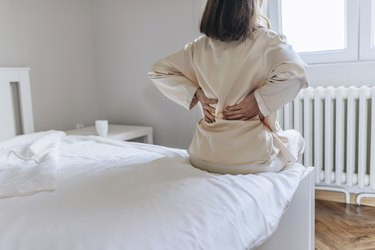
It's not your imagination: Your back has definitely gotten achier and more injury-prone as you've aged. But what's behind the growing discomfort, and is there anything you can do to make it go away?
Musculoskeletal pain isn't fun, but it's a common feature of getting older. Back pain is among the most typical complaints of all, affecting up to 75 percent of adults over 60, according to an October 2019 review published in the journal Clinics. And while it can't always be prevented, understanding the typical causes might help you keep the discomfort to a minimum (or even get rid of it altogether).
Video of the Day
Video of the Day
4 Reasons Why Back Pain Can Worsen With Age
There's a laundry list of problems that can cause back pain, many of which become more likely as we get older. Here are some of the most likely culprits:
After decades of hard work, parts of your spine can simply start to wear out. "It happens on multiple areas of the spine, including the discs and joints, which can culminate in back pain," explains Woo Jin Lee, MD, a pain management physician at Westerly Hospital in Rhode Island.
The cushioning that lines the spinal joints can start to degenerate, causing the joints to rub up against each other and become inflamed. The jelly-like substance that sits between each spinal disc can begin to lose moisture, upping the risk for pain and injuries such as torn discs or herniated discs.
These problems can add up to discomfort anywhere on the spine, including the neck. But wear and tear is most likely to lead to aches in your lower back, Dr. Lee says. "That's because those levels carry the bulk of our weight as well as allow us to move and twist our backs," he explains.
2. Increased Risk for Health Problems That Can Cause Back Pain
The normal wear and tear that happens with age can sometimes set the stage for chronic back conditions, according to the Cleveland Clinic. Some of the most common offenders include:
- Spinal stenosis, where the spinal cord and nerves become compressed and cause back and neck pain and weakness in the arms or legs.
- Spondylolisthesis, which happens when one vertebrae in the spine slips forward into another vertebrae.
- Arthritis, where the cartilage in the spine becomes thin and inflamed.
Another problem that's more likely to set in is osteoporosis, where the bones become weaker and more brittle. That might lead to hunching if the bones in the spine are affected, resulting in poor posture and pain.
Back pain isn't just the result of spine-related conditions — other health issues can also mimic, cause or exacerbate back pain. According to the National Institute of Arthritis and Musculoskeletal and Skin Diseases, these can include:
- Fibromyalgia
- Kidney stones or infections
- Stress
- Depression
3. Greater Likelihood of Injury
Speaking of osteoporosis, it's possible for the condition to cause tiny spinal fractures called microfractures. These fractures don't happen from an accident like tripping or falling, but instead, can develop when the bones in the spine aren't sturdy enough to support your weight or everyday activities. "They can simply present as lower back pain," Dr. Lee says.
Microfractures aren't the only injury that can make your back hurt. Repeated heavy lifting or awkward movements (like sudden twists or turns), can strain the muscles or ligaments in your back or even painful spasms, according to the Mayo Clinic.
4. Unhealthy Lifestyle Habits
A sedentary lifestyle can make your back and core muscles weaker, making you prone to poor posture and injury. Weight gain — which becomes more common with age — can put extra strain on your back and lead to discomfort too.
Controlling back pain depends on the underlying cause. Lifestyle changes can usually make a difference (especially when you put together a dedicated plan for back pain relief ), but sometimes other treatments like medication or even surgery might be necessary.
- Pay attention to your posture. It's the number-one way to promote good spinal health, Dr. Lee says. Hunching causes your back and core muscles to become weak, strained and stiff, which can lead to or exacerbate pain. "You should keep your spine as straight as you can on a daily basis," he recommends. These steps can help you perfect your posture.
- Be active. "Most patients have a false belief that when they have back pain, they need to rest and not stress your back anymore," Dr. Lee says. But being sedentary causes your back muscles to weaken, which can actually make the discomfort worse. Try to do low-impact aerobic activities on most days along with a few weekly sessions of back-strengthening and flexibility activities, like weight-lifting or yoga.
- Lift smart. When you need to lift a heavy object, bend at your knees rather than at your back, according to the Mayo Clinic. Try to maintain a normal posture while you carry the object (don't lean back or hunch forward) and avoid sudden twists or turns.
- Apply cold. Icing the affected area for 20 minutes can take down inflammation and help you feel more comfortable. Take a 20 minute break, then repeat as needed.
- Consider physical therapy. A physical therapist can teach you stretching and strengthening exercises that can help relieve your pain and make it easier to perform your everyday activities, per the Cleveland Clinic. Once you've learned the moves, you may be able to keep them up at home.
- Talk with your doctor about medications. Over-the-counter pain meds like acetaminophen or NSAIDs can ease inflammation and pain when lifestyle changes aren't giving you the relief you need. Opioids may be a short-term option for very severe pain, but they come with risks and side effects (like impaired judgment, nausea or constipation). You should weigh the pros and cons carefully with your physician before starting the meds, Dr. Lee says.
- Consider other treatments for severe pain. Steroid injections and minimally invasive procedures like radiofrequency ablation, lumbar decompression, vertebroplasty or kyphoplasty can all provide relief.
When to See a Doctor for Back Pain
"Back pain is an alarm system for the spine. It means that there's something wrong," Dr. Lee says.
In most cases, the problem will ease up with at-home measures like better posture and regular exercise. But you should let your doctor know if your back pain isn't getting better or is accompanied by new or worsening weakness, arm or leg numbness, heaviness or loss or control in the arms or legs, groin numbness or bladder or bowel issues, Dr. Lee says. In some cases, these symptoms could be a sign of a serious back problem such as a spinal tumor or a spinal infection.
- Clinic: "Prevalence of low back pain in the elderly population: a systematic review"
- Cleveland Clinic: "13 Ways to Fix Your Age-Related Back Pain"
- Mayo Clinic: "Back Pain"
- Mayo Clinic: "Back pain at work: Preventing pain and injury"
- Cleveland Clinic: "When (and How) Physical Therapy Can Provide Relief for Your Low Back Pain"
- National Institute of Arthritis and Musculoskeletal and Skin Diseases: "Back Pain"
Is this an emergency? If you are experiencing serious medical symptoms, please see the National Library of Medicine’s list of signs you need emergency medical attention or call 911.


